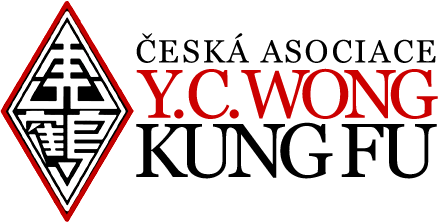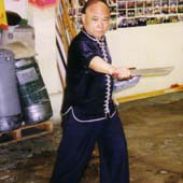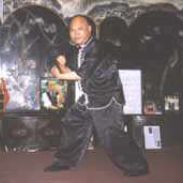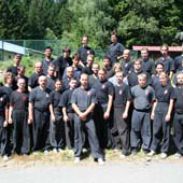Who's Who in American Martial Art: Y.C. Wong
Who's Who in American Martial Arts , American Martial Arts Publications, 1985, p. 94-95.
At the early age of six, in his native village in Canton, China, sifu Wong began his lifelong training under an old man skilled in Hungga as well in a few other Southern styles. At this point, Wong already showed dedication to his art, for he soon became able to mantain a squatting horse stance for nearly half an hour.
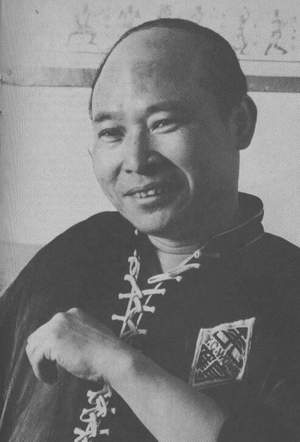
Economic hard times and the coming of World War II soon ended all serious training, however. Finally, at the age of eighteen, Wong left China and immigrated to Hong Kong. He had long heard of the famed Hungga expert, Lam Jou, teaching in Hong Kong, and asked to become his student. Thus, for the next 12 years, Wong lived at his teacher's school, trained under his teacher's personal supervision, and became his teacher's assistant instructor.
Having followed Lam Jou for many years, Wong learned and perfected the unarmed techniques and all the traditional Chinese weapons of the style. Upon nearly completing his training in Hungga, he studied the Northern Chinese style of pekgwa under a close friend of his teacher. This person was Gang Dakhoi, the famous old master skilled in a monkey style and pekgwa.
In 1963, Wong immigrated tothe U.S., eventually settling in San Francisco and starting his school there.
Within the last two decades, Wong has been active in promoting the art of gungfu. He is often present in martial arts demonstrations throughout the U.S., delighting the audience with his famed double steel whips and his lightning-fats two person empty handed or weapon sets. Wong was also one of the persons responsible for the first large gungfu demonstration in America, in 1968.
In the mid-1970's, Wong and a few other sifus attempted to unify the different gungfu schools into the Northern California Gungfu Federation. Wong was elected president of the federation for several terms.
Wong has maintained a personal touch in his gungfu classes. Unlike some schools which essentially have become chains which are so large that many assistant instructors are used, Wong continually attempts to teach his classes himslef as much as possible, explaining the history, philosophy and techniques of the style to his students. With schools in Santa Rosa, Sacramento and San Francisco, Wong now has a very busy schedule.
Personal and/or recommended training programm
Many years ago, when Wong was much younger, he trained extensively in the techniques of Hungga. However, after long years of experience in gungfu, Wong gradually realized that one should not continually overexert oneself in the use of power and speed. After all, one only has a certain limited resrvoir of hei (qi, the flow of energy) and overextending that would be detrimental to one's health. For many years now, he has favored balanced training. That is, Wong's representative style, Hungga, is a hard style in relation to other gungfu styles. Although he still practices its hand techniques, he also attempts to relax, to loosen up his body and limps, and to conserve his hei (qi) through training in such internal gungfu styles as taaigik (taiji), baatgwa (bagua) and Chinese meditation.
Personal and/or recommended diet
Actually, there's no special diet to help one keep in shape. What makes the difference is how one trains. Wong constantly advocates the concept of ballance in everything he does. One should not overexert and overtrain oneself; similarly, one should practice moderation in the types and amounts of food one consumes.
Philosophy of fighting
It is true that gungfu, as well any other martial art, can be seen as only a method for fighting efficiently. Obviously, no matter how skilled a person is, he should not make trouble or indiscriminately hurt people using his acquired gungfu skills. First, the purpose of gungfu is not to hurt others but to promote one's health and to be used as self-defense only if absolutely necessary. Second, no matter how highly skilled a person is, he is bound to meet someone even more skilled than he. Do keep in mind, thought, that gungfu is a skill that is also part of a heritage passed down through many generations of practitioners. Although gungfu training is not always an advantage in this age of guns, the essence of the art should be still preserved, and the essence not only includes the ability to do good-looking moves, but also the ability to use the technique effectively.
Are you a traditionalist or nontraditionalist?
The word "traditionalist" is vaguely defined. If you mean "traditionalist" in terms of traditional forms, Wong is for the most part a traditionalist. He does teach a style very close to what he learned many years ago. there is virtue to traditional gungfu as practiced by the many generations of earlier practitioners. Often there are principles built into the techniques so that if you start to change the techniques radically you would loose their effectiveness and essence. But this does not mean that the order of the techniques cannot be changed.
Wong is a traditionalist in another sense. He advocates the long-held traditional value of respecting your teacher and your style. After all, where did you learn your gungfu? If not from your sifu, you would not know what you know.
What is your attitide towards full-contact fighting?
The usefulness of full-contact fighting depends on you purpose. If one views full-contact fighting as a sport, it is OK, except that too many people are out for blood instead of competing in the spirit of sportsmanship and advancing one's skill.
On the other hand, the rules of full-contact fighting - though needed for participant's safety - are too limiting, and many may not do much to advance and to bring out the use of gungfu techniques. For instance, some styles have very effective gripping techniques, but gloves would immediately prevent the use of those techniques. Rule of no kicking below the waist is also very limiting. Some of the most effective kicks are below the belt.
Have you made any innovations in your style or training techniques?
Actually, a major innovation was made by grandmaster Lam Jou, many years ago. Although traditinally, Hungga practitioners practiced only a very hard style, Lam Jou began to soften the style a bit, and started to execute his techniques with a bit more fluidity. He also added principles of Northern styles to his techniques: he combined power with mobility. Lam Jou was well known for his ability to leap high and land as lightly and quietly as a cat and to execute moves as powerfully and ferociously as a tiger.
Wong has carried on this principle: Wong's Northern pekgwa style emphasises speed and mobility while Hungga stresses power and stability. The two complement each other well.
What are the special strengths of your style?
Hungga emphasises power and stability (strong stances and strong hand techniques). While some styles resort to sheer trickery to beat opponents, Hungga practitioners depend on speed and power as well as on their techniques to win; thus Hungga practitioners are traditionaly known as honest fighters.
Number of years needed to reach black belt/instructor level
A student's advancement in gungfu as in any other martial art depends on his inteligence, coordination and dedication. On the average, it takes a person three to seven years to reach a level of reasonable skill, again depending on the amount of practice.
